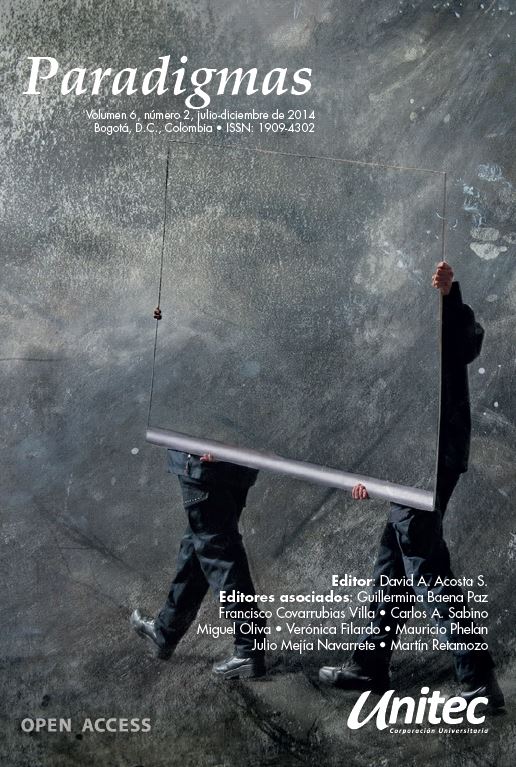Measuring corruption and its relationship with development and wellbeing in Latin America
Abstract
This paper seeks to identify, analyze and compare systems for measuring corruption and its association with wellbeing in Latin America. It will review the existing indicators on corruption and analyze the methodology for collecting data, and the production and frequency of indexes. It will establish correlations between measurements of corruption, human development and wellbeing. The paper concludes that, despite an increase in the number of measurements of corruption in Latin America, coverage is not complete and there are inconsistencies among the different indexes. In general terms, given the difficulty of obtaining reliable empirical data, the study of corruption tends to be based on subjective judgments. In other words, it is necessary to have access to timely, reliable, accessible and transparent information about the functioning of public and private institutions in order to adequately measure this phenomenon.
References
Andvig, J. & Odd-Helge, F. (2001). Corruption: A review of contemporary research. Report R 2001: 7. Bergen: Chr. Michelsen Institute Development Studies and Human Rights.
Banco Mundial (BM). (2000). Anticorruption in transition: A contribution to the policy debate. Washington, D.C. Recuperado desde http://documents.worldbank.org/curated/en/2000/09/693285/anticorruption-transition-contribution-policy-debate
Banco Mundial (BM). (2004). La revolución de los datos: cómo medir la gobernabilidad y la corrupción. Recuperado el Mayo 2014 desde http://www.bancomundial.org/temas/anticorrupcion/medir.htm
Banco Interamericano de Desarrollo (BID). (2001). Strengthening a systemic framework against corruption for the Inter-American Development Bank. Recuperado desde http://www.iadb.org/leg/Documents/Pdf/Corruption-EN.pdf
Bratsis, P. (2003). The construction of corruption, or rules of separation and illusions of purity in bourgeois societies. Social Text 77, 21(4), 9-33.
Botero, J. C., & Ponce, A. (2010). Measuring the Rule of Law. The World Justice Project - Working Paper Series WPS No. 001. Recuperado de http://ssrn.com/abstract=1966257
Canache, D., & Allison, M. E. (2005). Perceptions of political corruption in Latin American democracies. Latin American Politics and Society, 47(3). doi:10.1111/j.1548-2456.2005.tb00320.x
Centro de Investigaciones Económicas Nacionales (CIEN). (2012). Índice latinoamericano de transparencia presupuestaria, informe regional: México, Guatemala, Costa Rica, Venezuela y Ecuador. Guatemala: Fundar, Centro de Análisis e Investigación, A.C.
Credit Suisse (2013). Global Wealth Report. Zurich: Research Institute.
García, E. (1987). El problema de la corrupción: una revisión latinoamericana. Ilanud, (21-22). Recuperado de http://www.ilanud.or.cr/A075.pdf
Gaggero, J., Rua, M. & Gaggero, A. (2013). Argentina: fuga de capitales (2002-2012). Discussion Workshop, City University London. Recuperado desde file:///C:/Users/mgarzong/Downloads/Argentina.%20Fuga%20de%20capitales%20(2002-2012).pdf
Hardoon, D., & Heinrich, F. (2011). Índice de fuentes de soborno de Transparency International 2011. Recuperado de http://www.transparencia.org.es/INDICE%20DE%20FUENTES%20DE%20SOBORNO%202011/BPI2011_Informe_final_en_español.pdf
Henry, J. (2012). The price of offshore revisited: New estimates for missing global private wealth, income, inequality, and lost taxes. Tax Justice Network. Recuperado desde http://www.elcorreo.eu.org/IMG/pdf/Price_of_Offshore_Revisited_72612.pdf
Kaufmann, D. (2005). Corruption, governance security: Challenges for the rich countries and the world, Chapter 2.1 Global Competitiveness Report 2004/2005, World Bank Institute. Recuperado desde http://siteresources.worldbank.org/INTWBIGOVANTCOR/Resources/Kaufmann_GCR_101904_B.pdf
Khan, F. (2008). Understanding the spread of systematic corruption in the third world. American Review of Political Economy, 6(2), 16-39.
Langseth, P. R. (2006). Measuring corruption (Chapter 2). En Michael Porter, Scott Stern & Michael Green (2014), Social Progress Index. Washington, DC: Social Progress Imperative.
Mohabbat, M. (2004). Political and administrative corruption: Concepts, comparative experiences and Bangladesh case. A paper prepared for Transparency International - Bangladesh Chapter. Recuperado desde http://unpan1.un.org/intradoc/groups/public/documents/APCITY/UNPAN019105.pdf
Organización de las Naciones Unidas (ONU). (1989). Manual de indicadores sociales. Estudios de Métodos, Serie F N.º 49. Nueva York: Autor, Dpto. de Asuntos Económicos y Sociales Internacionales.
Programa de las Naciones Unidas para el Desarrollo (PNUD). (2003). Lecciones contra la corrupción. Nueva York: autor.
Reyes, F. (2008). Corrupción: de los ángeles a los índices. México: IFAI. Recuperado de http://inicio.ifai.org.mx/Publicaciones/frh2.pdf
Rico, J. & Salas, L. (1996). La corrupción pública en América Latina: manifestaciones y mecanismos de control (1a ed.). Miami: Centro para la Administración de Justicia.
Red Latinoamericana por la Transparencia Legislativa. (2012). Índice latinoamericano de transparencia legislativa: Argentina, Chile, Colombia, México, Perú. Recuperado desde: http://www.transparencialegislativa.org/publicacion/indice-latinoamericano-de-transparencia-legislativa-2/
Rose-Ackerman, S. (2004). The challenge of poor governance and corruption. Recuperado desde http://bolivien-tagung.de/Materialien/copenhagenconsensus_roseackerman.pdf
Rothstein, B. & Uslaner, E. M. (2005). All for all: Equality and social trust. World Politics, 58(1), 41-72. doi.10.1353/wp.2006.0022
Sánchez-Carrión, J. J. (2012). La encuesta: herramienta cognitiva. Papers. Revista de Sociología, 97(1), 169-192.
Stiglitz, J., Sen, A., & Fitoussi, J. P. (2008). Issues paper. Commission on the Measurement of Economic Performance and Social Progress. Tanzi, V. (1998). Corruption around the world. International Monetary Fund. Recuperado desde http://www.iuc-edu.eu/group/sem1_L2/BFC/reading/tanzi.pdf
The World Justice Project. (2013). Tables and methodology. Recuperado desde http://worldjusticeproject.org/rule-of-law-index
Transparency International. (2008). Poverty and corruption. Working Paper Nº 2. Recuperado desde http://www.transparency.ch/de/PDF_files/Divers/Poverty_and_Corruption__2008__-_WP.pdf
Transparency International. (2008). Human rights and corruption. Working Paper N° 5. Recuperado desde http://www.transparency.org/whatwedo/pub/working_paper_no._5_2008_human_rights_and_corruption
Transparency International. (2013). Global corruption barometer 2013, Frequently Asked Questions. Recuperado desde http://www.transparency.org/files/content/pressrelease/GCB2013_FAQs_EN.pdf
United States Agency for International Development (USAID). (1999). A handbook on fighting corruption. Technical Publication Series. Washington D.C.: Autor.
World Bank. (2006). Global Monitoring Report 2006. Washington DC: The International Bank for Reconstruction and Development / The World Bank. Recuperado de http://citeseerx.ist.psu.edu/viewdoc/download?doi=10.1.1.369.3737&rep=rep1&type=pdf
Copyright (c) 2014 Carlos Enrique Hernaíz, Mg., Mauricio Phélan, Ph.D., Jonathan E. Camacho, B.A.

This work is licensed under a Creative Commons Attribution-NonCommercial-NoDerivatives 4.0 International License.
Los artículos emplean licencias de acceso abierto distribuido bajo los términos de la licencia de Creative Commons 4.0 (https://creativecommons.org/licenses/by-nc-nd/4.0/), la cual permite su uso,
distribución y reproducción de forma libre siempre y cuando el o los autores reciban el respectivo crédito.




